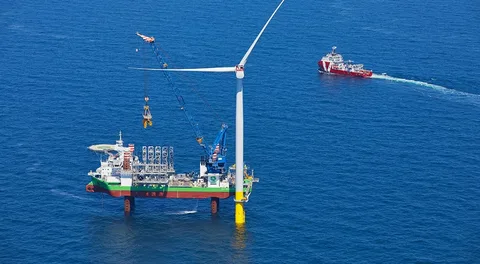Introduction
The Asia Pacific Offshore Wind Market is witnessing remarkable growth as countries in the region accelerate the transition toward renewable energy. Offshore wind farms harness wind energy over oceans and coastal areas, converting it into electricity for industrial, residential, and commercial applications. The Asia Pacific region, with its vast coastline and strong wind potential, has become a global hotspot for offshore wind investments.
Government incentives, renewable energy targets, and declining technology costs are key drivers of market expansion. Countries such as China, Japan, South Korea, and Taiwan are rapidly commissioning offshore wind projects to meet climate goals, reduce carbon emissions, and enhance energy security. Offshore wind provides stable, high-capacity energy generation compared to onshore wind and complements the growing energy demands of urbanized regions.
Market Dynamics
Drivers
- Renewable Energy Policies: National mandates and subsidies promote offshore wind adoption.
- Energy Security: Reduces dependency on imported fossil fuels.
- Technological Advancements: Floating turbines and high-capacity offshore platforms improve efficiency.
- Declining Costs: Economies of scale and advanced manufacturing reduce project costs.
- Grid Infrastructure Expansion: Improved offshore-to-shore transmission capabilities enhance viability.
Challenges
- High Capital Investment: Offshore wind projects require significant upfront costs.
- Environmental Concerns: Impact on marine ecosystems and coastal habitats.
- Technological Complexity: Installation and maintenance in harsh marine environments.
- Grid Integration Issues: Variability of wind energy requires robust transmission infrastructure.
Opportunities
- Floating Offshore Wind: Unlocks high-potential areas with deep-water locations.
- Corporate Power Purchase Agreements (PPAs): Increasing adoption by industrial consumers.
- Hybrid Renewable Projects: Integration with solar and battery storage for stable supply.
- Emerging Markets: Southeast Asia and India present high untapped potential.
- Local Manufacturing: Development of regional turbine and component supply chains.
Market Segmentation
By Turbine Type
- Fixed-Bottom Turbines: Traditional installation in shallow waters.
- Floating Turbines: Emerging solution for deep-water areas.
By Application
- Utility-Scale Offshore Farms: Large-scale energy generation.
- Industrial and Commercial Power: Direct supply to energy-intensive sectors.
- Residential Grid Supply: Integration into national power grids.
By Capacity
- Below 5 MW
- 5–10 MW
- Above 10 MW
By Region
- China: Dominates with the highest installed capacity and ambitious future plans.
- Japan: Focus on floating offshore wind to overcome deep-water challenges.
- South Korea: Investment in large-scale offshore wind projects for energy security.
- Taiwan: Rapid deployment of offshore wind farms supporting renewable energy targets.
- Southeast Asia & India: Emerging markets with high growth potential.
Regional Analysis
China leads the Asia Pacific Offshore Wind Market with massive installations along its eastern coast. Japan focuses on floating technology due to deep coastal waters. South Korea invests in large-scale farms for industrial supply and energy independence. Taiwan has become a regional leader in offshore wind deployment, while Southeast Asia and India are developing initial projects to tap renewable energy potential.
Key Trends
- Floating Offshore Turbines: Expanding beyond shallow waters for high-capacity projects.
- Digitalization: Predictive maintenance and remote monitoring improve efficiency.
- Hybrid Renewable Systems: Offshore wind combined with solar and storage for stable supply.
- Green Financing: Increasing private investment through sustainable bonds and funding.
- Local Content Initiatives: Governments encouraging domestic manufacturing of turbines and components.
Future Outlook
The Asia Pacific Offshore Wind Market is projected to grow exponentially over the next decade. Falling technology costs, government incentives, and ambitious renewable energy targets will drive large-scale deployments. Floating offshore wind technology will unlock deeper water sites, while hybrid systems and digitalization will enhance efficiency and reliability. By 2035, Asia Pacific is expected to account for the majority of global offshore wind capacity.
Conclusion
The Asia Pacific Offshore Wind Market is poised to transform the regional energy landscape, providing sustainable, high-capacity, and reliable power. Investment in floating technology, grid integration, and digitalization ensures that offshore wind will play a key role in achieving renewable energy goals and reducing carbon emissions.




